The Cuban Missile Crisis of October 1962 brought the world close to a nuclear confrontation between the United States and the Soviet Union. The political positions adopted by both sides nearly prevented a resolution, but at the last moment, a compromise was found and nuclear war averted.
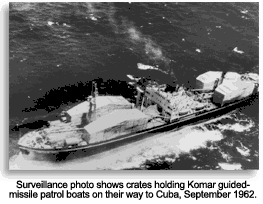 Putting ballistic missiles equipped with nuclear weapons into Cuba salved the insecurities of two men. Although John F. Kennedy had claimed that the U.S. lagged behind the Soviet Union in nuclear capabilities when he campaigned for the presidency, Soviet Premier Nikita Khrushchev knew otherwise. By the summer of 1962, Khrushchev also was certain that the Americans knew the same thing. Soviet missiles could reach Europe, but American missiles located in Turkey could strike almost anywhere in the Soviet Union. Khrushchev feared that the imbalance would tempt the U.S. to launch a first strike.
Putting ballistic missiles equipped with nuclear weapons into Cuba salved the insecurities of two men. Although John F. Kennedy had claimed that the U.S. lagged behind the Soviet Union in nuclear capabilities when he campaigned for the presidency, Soviet Premier Nikita Khrushchev knew otherwise. By the summer of 1962, Khrushchev also was certain that the Americans knew the same thing. Soviet missiles could reach Europe, but American missiles located in Turkey could strike almost anywhere in the Soviet Union. Khrushchev feared that the imbalance would tempt the U.S. to launch a first strike.
Fidel Castro harbored his own concerns. He had already withstood the Bay of Pigs Invasion in 1961 and President Kennedy made little effort to conceal his continued desire to see Castro deposed. Cuban intelligence had uncovered documents dating to April 1962 that described a plan to invade Cuba and overthrow Castro through Operation Mongoose, which ironically was scheduled for October 1962. Thus when Khrushchev proposed that the Soviet Union should install missiles in Cuba aimed at the U.S., Castro agreed.
Construction of missile sites began in mid-July 1962. By August, increased shipping activity between the Soviet Union and Cuba had come to the attention of American intelligence. On August 10, John McCone, director of the CIA, told Kennedy that, in his opinion, the Soviets intended to install medium-range ballistic missiles (MRBMs) in Cuba.
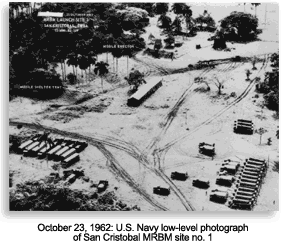 On August 29, a U-2 spy plane on reconnaissance over Cuba brought back evidence that surface-to-air (SAM) missiles had been installed at locations in Cuba. While not themselves offensive weapons, their installation indicated Cuba’s strong desire to defend those locations. Soviet Ambassador Anatoly Dobrynin advised Attorney General Robert F. Kennedy, who was one of President Kennedy's closest advisors, that the installations were entirely defensive in nature. But in fact, MRBMs began to arrive 11 days later.
On August 29, a U-2 spy plane on reconnaissance over Cuba brought back evidence that surface-to-air (SAM) missiles had been installed at locations in Cuba. While not themselves offensive weapons, their installation indicated Cuba’s strong desire to defend those locations. Soviet Ambassador Anatoly Dobrynin advised Attorney General Robert F. Kennedy, who was one of President Kennedy's closest advisors, that the installations were entirely defensive in nature. But in fact, MRBMs began to arrive 11 days later.
Continued reports of Soviet missiles in Cuba prompted the decision to send another U-2 to take a closer look on October 9. Bad weather delayed the flight until October 14. The photographic evidence was analyzed and in addition to the SAMs, six larger missiles, 60 to 65 feet in length, were identified. It was clear to analysts on the 15th that those missiles were likely to have nuclear capability.
Kennedy was informed of the situation during his breakfast on the 16th. He quickly convened the Executive Committee of the National Security Council (EX-COMM). That hand-picked group of 12 men would advise Kennedy throughout the unfolding crisis. They included Secretary of State Dean Rusk, Secretary of Defense Robert S. McNamara, CIA Director John McCone, Secretary of the Treasury Douglas Dillon, National Security Adviser McGeorge Bundy, Presidential Counsel Ted Sorenson, Undersecretary of State George Ball, Deputy Undersecretary of State U. Alexis Johnson, Joint Chiefs of Staff Chairman Maxwell Taylor, Assistant Secretary of State for Latin America Edward Martin, Adviser on Russian Affairs Llewellyn Thompson, Deputy Secretary of Defense Roswell Gilpatric, and Assistant Secretary of Defense Paul Nitze
Kennedy wanted to maintain complete secrecy. He did not want the Soviets to know how much he knew and he also didn't want to panic the American public. So for the next four days, Kennedy maintained his announced schedule of public appearances. On the 17th, the president flew to Connecticut in support of Abraham Ribicoff's bid for a U.S. Senate seat. On the same day, another U-2 flight revealed the existence of intermediate-range ballistic missiles (IRBMs) that would be able to strike nearly anywhere in the continental United States.
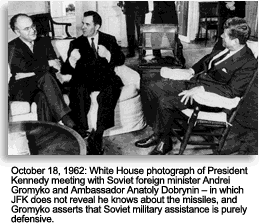 On the 18th, Kennedy met with Soviet Foreign Minister Andrei Gromyko. The missiles were not directly brought into the discussions by either side. Gromyko again denied that the Soviet Union was doing anything in Cuba except assisting in that country's defense. Kennedy re-read his statement from September 4, in which he had said that offensive weapons in Cuba would not be tolerated. That evening, Kennedy received a recommendation from EX-COMM to blockade Cuba rather than launch a military strike. Kennedy agreed, but instructed his speechwriter, Theodore Sorenson, to prepare two speeches: One would announce the blockade and the other an invasion.
On the 18th, Kennedy met with Soviet Foreign Minister Andrei Gromyko. The missiles were not directly brought into the discussions by either side. Gromyko again denied that the Soviet Union was doing anything in Cuba except assisting in that country's defense. Kennedy re-read his statement from September 4, in which he had said that offensive weapons in Cuba would not be tolerated. That evening, Kennedy received a recommendation from EX-COMM to blockade Cuba rather than launch a military strike. Kennedy agreed, but instructed his speechwriter, Theodore Sorenson, to prepare two speeches: One would announce the blockade and the other an invasion.
Kennedy continued to appear in public as though nothing were happening. On the 19th, he flew to the Midwest for a series of campaign appearances. Meanwhile, back in Washington, his brother Robert continued intense discussions with EX-COMM. The Joint Chiefs of Staff wanted to exercise the military option, but consensus couldn't be reached. On the following day, Robert told the president that he must return to Washington for a final decision. It was announced that he was suffering from an "upper respiratory infection," and flew back. In the early afternoon, he met with EX-COMM. Given the choice between limited action in the form of a blockade and military action that might become unstoppable, Kennedy favored the blockade. He would not make a final decision, however, until the 21st.
On Sunday, October 21, Kennedy decided to address the nation the following day and tell them of his decision. He chose the word "quarantine" to describe his naval action rather than "blockade." Under international law, a blockade is an act of war, while a quarantine is less clear cut. Responding to growing inquiries from the press, Kennedy requested that they publish nothing provocative in the delicate situation that prevailed. Such major newspapers as the New York Times and the Washington Post held back their coverage.
Beginning at 7 p.m. EST on October 22, 1962, President Kennedy addressed the nation on television. During his 17-minute speech, he explained the evidence of the Soviet missile buildup, declared a quarantine against weapons deliveries to Cuba, and issued blunt warnings to the Soviet Union. Not knowing how the Soviets would react, he had already placed American military forces on high alert. Missiles had been readied for launch within minutes and 20 SAC bombers were airborne, equipped with nuclear bombs. Khrushchev responded with a letter to Kennedy, denying again that the weapons were anything but defensive and warning the U.S. of possible catastrophic consequences if they continued along their announced path.
 On the 23rd, reconnaissance flights by six Crusader jets, flying just 350 feet above the ground, brought back pictures that showed missiles being tested for launch. The Organization of American States (OAS) unanimously approved the quarantine of Cuba. With the OAS endorsement in hand, the United States announced that the quarantine would begin on the 24th at 10 a.m., at a line 500 miles from Cuba.
On the 23rd, reconnaissance flights by six Crusader jets, flying just 350 feet above the ground, brought back pictures that showed missiles being tested for launch. The Organization of American States (OAS) unanimously approved the quarantine of Cuba. With the OAS endorsement in hand, the United States announced that the quarantine would begin on the 24th at 10 a.m., at a line 500 miles from Cuba.
Robert Kennedy met privately with Ambassador Dobrynin and complained bitterly that Dobrynin had lied to him about the missiles. Dobrynin stated that to the best of his knowledge, the missiles were entirely defensive. After the meeting, Dobrynin cabled Moscow with a report of the meeting. Lacking sophisticated communications, Dobrynin was obliged to use Western Union, which sent a messenger by bicycle to pick up the wire.
The U.S. Navy began to enforce the quarantine with 56 warships, including eight aircraft carriers, at 10 a.m. on October 24. At 10:25 a.m., EX-COMM was informed that Soviet ships had turned away from the quarantine line. While that averted an immediate confrontation, the missiles already in Cuba constituted an ongoing threat. SAC headquarters put its forces around the world on the highest level of alert ever. Communications were sent uncoded, so that the Soviets would have no misconceptions regarding America’s intent. That evening, another letter from Khrushchev arrived, which described the American position as an ultimatum to which the Soviets would not submit.
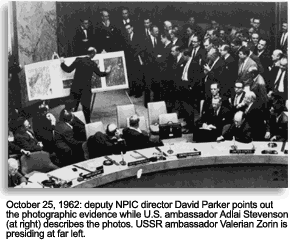 On the 25th, Kennedy instructed U.N. Ambassador Adlai E. Stevenson to confront Soviet Ambassador Valerian Zorin about the missiles. Zorin refused to comment. Stevenson showed him reconnaissance photos that clearly showed the launch sites. At that point, well-known columnist Walter Lippman published an appeal for a face-saving compromise. He noted that the U.S. had missiles in Turkey, 150 miles from the Soviet Union, and suggested that the U.S. should agree to remove those if the Soviets removed theirs from Cuba. Although many people thought Kennedy was sending up a "trial balloon" through Lippman, he was actually acting on his own. At the end of the 5 p.m. EX-COMM meeting, CIA director McCone informed the group that Soviet missiles in Cuba were operational.
On the 25th, Kennedy instructed U.N. Ambassador Adlai E. Stevenson to confront Soviet Ambassador Valerian Zorin about the missiles. Zorin refused to comment. Stevenson showed him reconnaissance photos that clearly showed the launch sites. At that point, well-known columnist Walter Lippman published an appeal for a face-saving compromise. He noted that the U.S. had missiles in Turkey, 150 miles from the Soviet Union, and suggested that the U.S. should agree to remove those if the Soviets removed theirs from Cuba. Although many people thought Kennedy was sending up a "trial balloon" through Lippman, he was actually acting on his own. At the end of the 5 p.m. EX-COMM meeting, CIA director McCone informed the group that Soviet missiles in Cuba were operational.
On the 26th, the U.S. Navy boarded the Lebanese freighter Marcula. It found only paper products and permitted the ship to continue to Cuba. A Soviet ship, which was not suspected of carrying weapons, was also allowed through. During the evening, another letter from Khrushchev was received. That eloquent letter spoke of the escalation of activities between both sides and of a proposal for the Soviets to withdraw their missiles in return for a pledge by the United States not to invade Cuba. Later that evening, Robert Kennedy again visited Dobrynin at the Soviet Embassy. The question of missiles in Turkey was raised and Kennedy suggested that a trade might be possible. Dobrynin relayed this information to Moscow.
Saturday, October 26, was extremely tense as events brought the two countries closer to war than they had before. A U-2 plane on a routine flight in Alaska got lost and strayed into Soviet airspace. The Soviets responded by sending a fighter group to intercept the U-2 and American fighters were sent in response. Fortunately, the U-2 was able to leave Soviet airspace without the fighter groups making contact with each other. Meanwhile, in Cuba, a U-2 was shot down. That was considered by the United States to be evidence that the Soviets were escalating the conflict, but in actuality, the orders had come from a local commander without approval from Moscow.
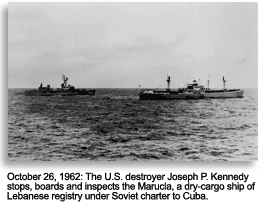 Khrushchev sent another letter, which demanded that the U.S. withdraw its missiles from Turkey in return for the Soviets pulling theirs out of Cuba. The exchange actually favored the Americans. The Jupiter missiles in Turkey were not well regarded by American military strategists and represented less of a strategic position than the Soviet missiles in Cuba. However, in order to avoid delays in communications, Khrushchev’s letter had been broadcast. By making their demands public, the Soviets were making it difficult for the Americans to accept the proposal.
Khrushchev sent another letter, which demanded that the U.S. withdraw its missiles from Turkey in return for the Soviets pulling theirs out of Cuba. The exchange actually favored the Americans. The Jupiter missiles in Turkey were not well regarded by American military strategists and represented less of a strategic position than the Soviet missiles in Cuba. However, in order to avoid delays in communications, Khrushchev’s letter had been broadcast. By making their demands public, the Soviets were making it difficult for the Americans to accept the proposal.
At that critical juncture, Robert Kennedy proposed that the U.S. simply ignore the second letter and respond to the first. At 8:05 p.m., President Kennedy announced that he agreed to what he understood Khrushchev's position to be, and that if the Soviets would agree to withdraw their missiles, the United States would end the quarantine and promise not to invade Cuba.
Khrushchev met with his advisors and decided he was not prepared to start a war. He drafted a response in which he thanked Kennedy for his "sense of proportion and understanding." The message was received at 9 a.m. on Sunday, October 28, effectively ending the crisis. However, not all members of EX-COMM were convinced that this was anything but a Soviet delay. Air Force General Curtis Lemay, chief of staff, argued that the United States should attack Cuba on the following day anyway, but the majority disagreed.
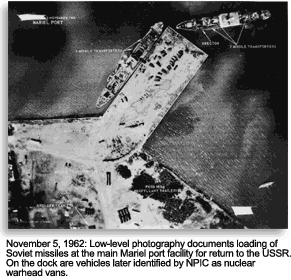 Privately it was agreed that the Jupiter missiles positioned in Turkey would be withdrawn in a few months, but that the decision would not be publicly tied to the agreement about Cuba. The question of Soviet bombers stationed in Cuba had not been specifically addressed, but the U.S. used Khrushchev's promise to remove all "weapons which you describe as offensive" to argue for their removal as well. Also, to solve the communication delays between the two countries, a new ¹“hot line” was later installed so that in the future the White House and the Kremlin could talk directly.
Privately it was agreed that the Jupiter missiles positioned in Turkey would be withdrawn in a few months, but that the decision would not be publicly tied to the agreement about Cuba. The question of Soviet bombers stationed in Cuba had not been specifically addressed, but the U.S. used Khrushchev's promise to remove all "weapons which you describe as offensive" to argue for their removal as well. Also, to solve the communication delays between the two countries, a new ¹“hot line” was later installed so that in the future the White House and the Kremlin could talk directly.
On November 20, the Soviet Union began the process of dismantling the bombers and shipping them back. On the following day, President Kennedy formally ended the quarantine. The Cuban Missile Crisis was over and thus a nuclear confrontation with the Soviet Union was avoided.
1: "Hot line" The US-USSR hot line provided for a two-way telegraphic link routed via Washington-London-Copenhagen-Stockholm-Helsinki- Moscow, to be used for transmission of messages; and a stand-by radio link routed Washington-Tangier-Moscow. Both the telegraphic and radio links would be open 24 hours a day.